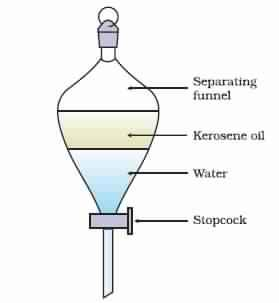
Separation of two immiscible liquids is based on:
(a) Difference in the solubility of the two liquids
(b) Difference in densities of the two liquids
(c) Difference in melting point of the two liquids
(d) Difference in boiling point of the two liquids
Answer
591.6k+ views
Hint: To answer this question, we must first clearly understand when and why are two liquids immiscible. We should also recall the concepts of separation of mixtures.
Complete step by step solution:
Immiscible liquids are those liquids which will not mix with each other to give a single phase. Oil and water are examples of immiscible liquids - one floats on top of the other. Though classified as immiscible, in actual fact, there is still some degree of mutual solubility. For example, in benzene and water, a small amount of benzene will be dissolved in the water phase, and vice versa.
Since by definition, immiscible liquids do not interact with each other in any way whatsoever, they will evaporate completely independent of each other.
For separating immiscible liquids like oil and water we use separating funnels.
The principle of separating funnels is that immiscible liquids separate out in layers depending on their densities.
Hence, the correct answer is Option (B) Difference in densities of the two liquids
Additional information:
We can separate a mixture of Kerosene oil and water in the following way.
1- Pour the mixture of kerosene oil and water in a separating funnel
2- Let it stand undisturbed for sometime so that separate layers of oil and water are formed.
3- Open the stopcock of the separating funnel and pour out the lower layer of water carefully.
4- Close the stopcock of the separating funnel as the oil reaches the stop-cock.

Note: This principle of separation of immiscible fluids on the basis of densities also finds application in the extraction of iron from its ore. The lighter kerosene oil is collected at the top of the separating funnel while heavier water will be pore out from the bottom.
Complete step by step solution:
Immiscible liquids are those liquids which will not mix with each other to give a single phase. Oil and water are examples of immiscible liquids - one floats on top of the other. Though classified as immiscible, in actual fact, there is still some degree of mutual solubility. For example, in benzene and water, a small amount of benzene will be dissolved in the water phase, and vice versa.
Since by definition, immiscible liquids do not interact with each other in any way whatsoever, they will evaporate completely independent of each other.
For separating immiscible liquids like oil and water we use separating funnels.
The principle of separating funnels is that immiscible liquids separate out in layers depending on their densities.
Hence, the correct answer is Option (B) Difference in densities of the two liquids
Additional information:
We can separate a mixture of Kerosene oil and water in the following way.
1- Pour the mixture of kerosene oil and water in a separating funnel
2- Let it stand undisturbed for sometime so that separate layers of oil and water are formed.
3- Open the stopcock of the separating funnel and pour out the lower layer of water carefully.
4- Close the stopcock of the separating funnel as the oil reaches the stop-cock.

Note: This principle of separation of immiscible fluids on the basis of densities also finds application in the extraction of iron from its ore. The lighter kerosene oil is collected at the top of the separating funnel while heavier water will be pore out from the bottom.
Recently Updated Pages
Why are manures considered better than fertilizers class 11 biology CBSE

Find the coordinates of the midpoint of the line segment class 11 maths CBSE

Distinguish between static friction limiting friction class 11 physics CBSE

The Chairman of the constituent Assembly was A Jawaharlal class 11 social science CBSE

The first National Commission on Labour NCL submitted class 11 social science CBSE

Number of all subshell of n + l 7 is A 4 B 5 C 6 D class 11 chemistry CBSE

Trending doubts
Differentiate between an exothermic and an endothermic class 11 chemistry CBSE

10 examples of friction in our daily life

One Metric ton is equal to kg A 10000 B 1000 C 100 class 11 physics CBSE

Difference Between Prokaryotic Cells and Eukaryotic Cells

1 Quintal is equal to a 110 kg b 10 kg c 100kg d 1000 class 11 physics CBSE

State the laws of reflection of light




